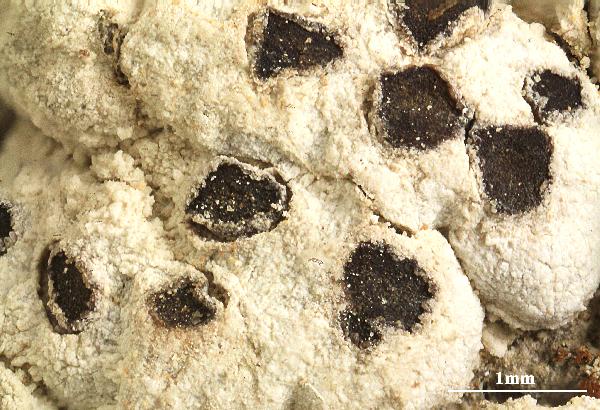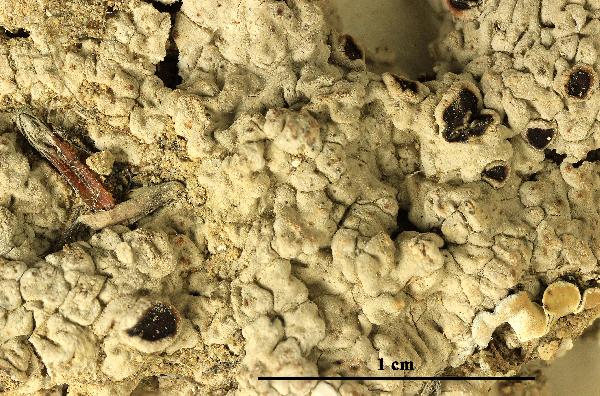Acarospora nodulosa (Dufour) Hue var. nodulosa
Nouv. Arch. Mus. Hist. Nat. Paris, 5 sér., 1: 160, 1909. Basionym: Parmelia nodulosa Dufour in Fries - Lich. Eur. Ref.: 185, 1831.
Synonyms: Lecanora nodulosa (Dufour) Colmeiro nom. illegit. non Stirt.; Urceolaria nodulosa (Dufour) Schaer.
Distribution: N - Emil (Nimis & al. 1996, Fariselli & al. 2020). S - Cal (CLU 16060).
Description: Thallus areolate-subsquamulose, densely chalky white-pruinose, forming up to 5 cm wide patches. Areoles (2-)3-5(-6) mm wide, 0.2-2 mm thick, rounded, mostly convex, slightly lobed; lower surface white or black and corticate, attached by a few rhizohyphae. Cortex prosoplectenchymatous, with a palisade of anticlinally arranged hyphae spreading from hyphal bundles penetrating through the algal layer, 50-70 µm thick, densely filled with crystals visible under polarized light; algal layer uneven, interrupted by hyphal bundles; medulla prosoplectenchymatous, white, opaque, with many crystals. Apothecia lecanorine, 1-2(-3) mm across, round, at first immersed, later sessile, with a flat to slightly convex, dark brown to almost black, epruinose disc, and a thick thalline margin. Proper exciple expanding to c. 70 µm, forming thin ring around disc; epithecium yellowish brown, , c. 10 μm high, K- or K+ yellow then red (needle-like crystals); hymenium colourless to pale yellow, 50-180 μm high, the hymenial gel euamyloid, IKI+ persistently dark blue; paraphyses coherent, simple to sparingly branched in upper part, 1.5-2.5 μm thick at base, the apical cell slightly swollen; hypothecium colourless, 40-85 μm high, K+ yellow turning red (acicular crystals). Asci c. 100-spored, cylindrical-clavate, with a distinct apical dome, K/I-, 45-110 x 13-20 µm. Ascospores 1-celled, hyaline globose or subglobose, (3-)4-6 x 3-7 μm. Pycnidia ofen submarginal, immersed, globose, 100-150 µm across, with a colourless wall. Conidia bacilliform, 2-3 x 1-1.4 µm. Photobiont chlorococcoid. Spot tests: thallus K-, C-, KC-, P-, UV-. Chemistry: apothecia with norstictic acid, often hardly detectable.Note: a xeric subtropical species of weathered gypsum in open habitats, usually below the montane belt. To be looked for in other gypsum outcrops (e.g. in Sicilia).
Growth form: Crustose
Substrata: rocks, soil, terricolous mosses, and plant debris
Photobiont: green algae other than Trentepohlia
Reproductive strategy: mainly sexual
Subcontinental: restricted to areas with a dry-subcontinental climate (e.g. dry Alpine valleys, parts of Mediterranean Italy)
paras Diploschistes diacapsis
Commonnes-rarity: (info)
Alpine belt: absent
Subalpine belt: absent
Oromediterranean belt: absent
Montane belt: absent
Submediterranean belt: extremely rare
Padanian area: absent
Humid submediterranean belt: absent
Humid mediterranean belt: absent
Dry mediterranean belt: absent

Predictive model
Herbarium samples


P.L. Nimis; Owner: Department of Life Sciences, University of Trieste
Herbarium: TSB (9444)
2001/11/21


Felix Schumm – CC BY-SA 4.0
Image from: F. Schumm (2008) - Flechten Madeiras, der Kanaren und Azoren. Beck, OHG - ISBN: 978-3-00-023700-3


Felix Schumm - CC BY-SA 4.0
Image from: F. Schumm (2008) - Flechten Madeiras, der Kanaren und Azoren. Beck, OHG - ISBN: 978-3-00-023700-3


Felix Schumm - CC BY-SA 4.0
Image from: F. Schumm (2008) - Flechten Madeiras, der Kanaren und Azoren. Beck, OHG - ISBN: 978-3-00-023700-3

Ulrich Kirschbaum CC BY-SA 4.0 - Source: https://www.thm.de/lse/ulrich-kirschbaum/flechtenbilder
E; Canary Islands; La Gomera-M; e of Chipude: Top of the Fortaleza.

Ulrich Kirschbaum CC BY-SA 4.0 - Source: https://www.thm.de/lse/ulrich-kirschbaum/flechtenbilder
E; Canary Islands; La Gomera-M; e of Chipude: Top of the Fortaleza.

Ulrich Kirschbaum CC BY-SA 4.0 - Source: https://www.thm.de/lse/ulrich-kirschbaum/flechtenbilder
E; Canary Islands; La Gomera-M; e of Chipude: Top of the Fortaleza.


Felix Schumm - CC BY-SA 4.0
[VZ1561], Persia austro-occidentlis. Bushir, 60 km in austro-occidentem
a vico Khormuj. Ad terram gypsaceam. Leg. J. Soják,
20.04.1977, det. A. Vezda. - Ex A. VEZDA: LICHENES SELECTI EXSICCATI
NR. 1561.


Felix Schumm - CC BY-SA 4.0
[VZ1561], Persia austro-occidentlis. Bushir, 60 km in austro-occidentem
a vico Khormuj. Ad terram gypsaceam. Leg. J. Soják,
20.04.1977, det. A. Vezda. - Ex A. VEZDA: LICHENES SELECTI EXSICCATI
NR. 1561.
Growth form: Crustose
Substrata: rocks, soil, terricolous mosses, and plant debris
Photobiont: green algae other than Trentepohlia
Reproductive strategy: mainly sexual
Subcontinental: restricted to areas with a dry-subcontinental climate (e.g. dry Alpine valleys, parts of Mediterranean Italy)
paras Diploschistes diacapsis
Commonnes-rarity: (info)
Alpine belt: absent
Subalpine belt: absent
Oromediterranean belt: absent
Montane belt: absent
Submediterranean belt: extremely rare
Padanian area: absent
Humid submediterranean belt: absent
Humid mediterranean belt: absent
Dry mediterranean belt: absent

Predictive model
| Herbarium samples |


P.L. Nimis; Owner: Department of Life Sciences, University of Trieste
Herbarium: TSB (9444)
2001/11/21


Felix Schumm – CC BY-SA 4.0
Image from: F. Schumm (2008) - Flechten Madeiras, der Kanaren und Azoren. Beck, OHG - ISBN: 978-3-00-023700-3


Felix Schumm - CC BY-SA 4.0
Image from: F. Schumm (2008) - Flechten Madeiras, der Kanaren und Azoren. Beck, OHG - ISBN: 978-3-00-023700-3


Felix Schumm - CC BY-SA 4.0
Image from: F. Schumm (2008) - Flechten Madeiras, der Kanaren und Azoren. Beck, OHG - ISBN: 978-3-00-023700-3

Ulrich Kirschbaum CC BY-SA 4.0 - Source: https://www.thm.de/lse/ulrich-kirschbaum/flechtenbilder
E; Canary Islands; La Gomera-M; e of Chipude: Top of the Fortaleza.

Ulrich Kirschbaum CC BY-SA 4.0 - Source: https://www.thm.de/lse/ulrich-kirschbaum/flechtenbilder
E; Canary Islands; La Gomera-M; e of Chipude: Top of the Fortaleza.

Ulrich Kirschbaum CC BY-SA 4.0 - Source: https://www.thm.de/lse/ulrich-kirschbaum/flechtenbilder
E; Canary Islands; La Gomera-M; e of Chipude: Top of the Fortaleza.


Felix Schumm - CC BY-SA 4.0
[VZ1561], Persia austro-occidentlis. Bushir, 60 km in austro-occidentem a vico Khormuj. Ad terram gypsaceam. Leg. J. Soják, 20.04.1977, det. A. Vezda. - Ex A. VEZDA: LICHENES SELECTI EXSICCATI NR. 1561.


 INDEX FUNGORUM
INDEX FUNGORUM
 GBIF
GBIF










